
- By Theme
-
Destinations
-
Indian Destinations
-
International Destinations
-
- Best Places to Visit
- Packages
- Search Agents
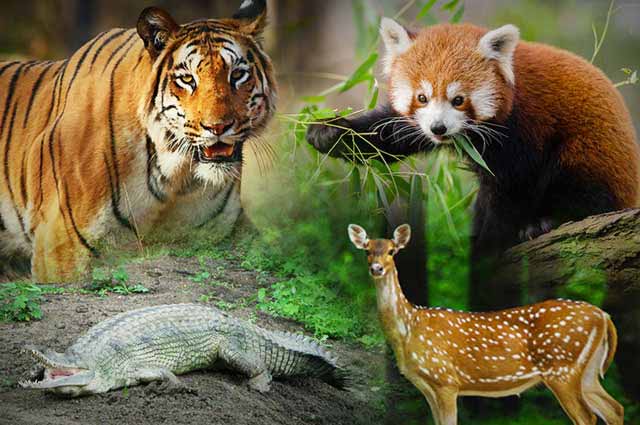
Humans have the unquenchable thirst to explore the true essence of nature. What better way to satisfy this thirst than to go on a wildlife safari! Strolling through the woods and enjoying the sheer beauty that nature can offer is bliss. And if you get lucky, you can spot a rare and endangered animal taking their routine stroll in the wilderness.
India is blessed with rich flora and fauna and to conserve them from further depletion, the government of the country has created as many as 500 national parks and wildlife sanctuaries. From the endangered rhino and tigers in Kaziranga and Corbett to the majestic Asiatic lion and snow leopard in Gir and Hemis, one can proudly boast about the rich wildlife of India.
If you are also an adventure seeker and want to enjoy the company of these jungle beasts in their natural habitat, then choose from the wildlife sanctuaries in India enlisted below and get going.

Situated on the hot sands in the town of Jaisalmer, Rajasthan, Desert national Park is Indias lone desert national park that is spread over a wide area of 3162 sq kms, close to the border of Pakistan. This region boasts limited species like blackbuck, desert fox, wolves and chinkara. The bird like partridge, buzzards and larks are the ones found in this area. The Indian desert safari or the camel ride is the best way to explore the park. The scorching summers should be avoided and other seasons are best suited for a visit. Reaching here is extremely comfortable as you can choose any mode of air, road or railways.
Entry Fee- 20 INR for Indians & 160 INR for foreigners

Surrounded with regal air it borrows from the older times is Eturnagaram wildlife sanctuary that is located in the Warangal district of Telangana 250 kms away from Hyderabad. The dense woods are a home to spectacular species like giant squirrels, chinkaras, panthers, Indian bisons etc. making it a famous wildlife sanctuary in India. Well connected via airways and railways, a short road journey via jeep takes to the sanctuary where a safari can be enjoyed. October-May is the right time for visiting the sanctuary with family.
Entry Fee- No entry fee

According to the folklore, Bhimbandh Wildlife Sanctuary got its name after a dam that was constructed by the 2nd Pandava Bhim on river Ganges. Established in the year 1976, Bhimbandh wildlife sanctuary is situated in the forests of southwest Munger district of Bihar. BBWS boasts a large variety of fauna that brings it in the list of special and popular wildlife sanctuaries in India. Big cats like tigers, leopards and panthers, bears, fishing cat, stags, antelopes etc are largely found in the sanctuary. The best time to visit the sanctuary is around the calendar excluding the burning summers. It is 22 kms away from railways and 200 kms from Patna airport.
Entry fee- Not Available

Located on the western fringe of Chota Nagpur plateau, Palamau tiger is one of the first nine tiger reserves created at the inception of project tiger. Extended in the area of 1129.93 km2, visiting this reserve should be a sure shot thing for a person who loves the thrill of being near wild. The precincts can be visited all year round. Winter are pleasant at Palamau, but is it easier for humans to spot wild animals near the waterholes in summer.
Entry Fee- Rs 25 (Indians)/Rs 200 (Foreigners)

The prepossessing grounds of Mudumalai National Park are situated at the tri-junction of Tamil Nadu, Kerala, and Karnataka. The USP of Mudumalai is the 50 tigers it homes in its boundaries (Mudumalai owns the status of having highest tiger population density in India). The reserve is Tamil Nadus one of best places to spot creatures like deer, wild boar, peacocks, langurs and Malabar giant squirrels, etc.
Entry Fee- Rs. 15.0 /person, Rs 25.0 For still Cameras, Rs. 150.0 For Video Cameras, and Rs 135.0 /person For jeep safari.

Spread across the wide area of 643 km2, Nagarhole is Karnatakas one of best the places to seek wildlife, alongside the bay of a scenic lake. The lush green forests home 270 species of birds, along with tigers, elephants, leopards, dhole, barking deer, etc. You can visit the park at any time before 6:15; however, the park remains close for long stretches between July and October.
Entry Fee- Rs. 50/ person, and Rs. For camera

Located in the Chikkamagaluru town in Karnataka, Bhadra Wildlife Sanctuary is one of the most popular wildlife sanctuaries of South India. Spread across an area of 492 sq. km., this sanctuary is a home for as many as 120 species of flora and more than 30 species of mammals. One can easily witness migratory birds and colorful butterflies fluttering in the sky overhead.
Entry Fee- Free entry for everyone!!!

Famed to be Maharashtras oldest and largest national park, Tadoba Andhari Tiger Reserve is a home to 88 tigers. Apart from the Bengal tiger, animals like sloth bears, Indian leopards, nilgai, sambar, barking deer etc can be seen taking their regular stroll. There are 74 species of colorful butterflies like pansies, Mormons, swordtails etc. Enjoy the company of these jungle beasts in your Jeep Safari and get closer to nature.
Entry Fee- INR 20 per person.
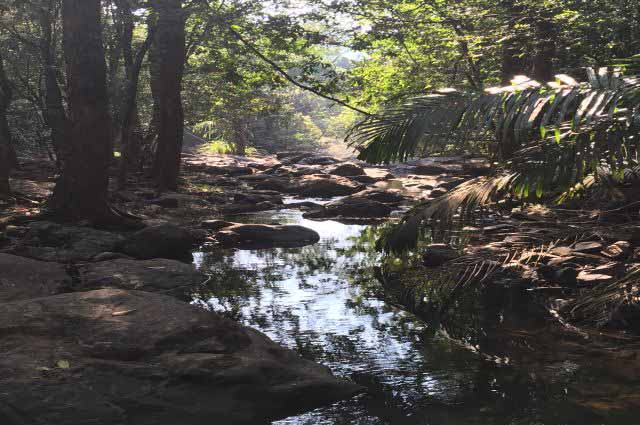
Nestled in the Western Ghats of Goa and sharing eastern borders with Karnataka, Bhagwan Mahavir Wildlife Sanctuary is rich in wildlife. You can take a stroll to the Devils Canyon View Point to catch a glimpse of the wild animals. Widely known for leopards, elephants, gaurs and deer, it is also a paradise for bird lovers. One can enjoy some quiet time with family and friends while on a trip to this wildlife sanctuary.
Entry Fee- INR 20 for adults and INR 5 for children.

Famous for its avifauna sanctuary, housing thousands of birds, Bharatpur Bird Sanctuary is located in the Bharatpur area of Rajasthan. There are numerous animals like golden jackal, nilgai, sambar, blackbuck etc that can be spotted in the national reserve area of Keoladeo. People also visit this park to pay their homage to Lord Shiva (Keoladeo) after whom this place was named. Covering an area of 27 sq. km., it is not that big a park and can be travelled on foot or by the rickshaws that are available. You can also enjoy boating in Keoladeo.
Entry Fee- INR 25 for Indians and INR 200 for foreigners.

The Jim Corbett National park is the oldest national park of the country and is a protected home to the endangered Bengal tiger. Located in the Nainital District of Uttarakhand, this national park is spread over an area of 520 sq. km and houses 448 different species of plants and animals. Bird watchers can treat their eyes with the blossom-headed parakeet, red junglefowl and other birds that flock this place. You can easily spot leopards and herds of Indian elephant strolling in the area. The best time to visit this place is from November to June. You can stay in the Dhikala Forest lodge and enjoy jungle safari for days.
Entry Fee- INR 4,000 for Indians and INR 7,000 for foreigners for a Jeep Safari. INR 1,500 and INR 3,000 for Canter Safari for Indians and foreigners respectively. INR 500 and INR 1,500 for elephant safari for the Indians and foreigners resp.

A treat for all the tiger lovers, Sunderbans National Park is a habitat for more than 400 tigers. Located in West Bengal, this national park is also a Tiger Reserve as well as a Biosphere Reserve. Its location in the Sunderbans of the Ganges Delta, which is covered with mangrove trees, makes it an apt place for housing royal Bengal tigers. They can be easily seen sunbathing or dipping in the saline waters between the months December to February. It remains open from September to March as many migratory birds flock here at this time. The nearest airport is Calcutta and the nearest Railway Station is Canning; this makes it a not-so-easy to access site.
Entry Fee- INR 15 for Indians and INR 150 for foreigners.

Housing around 55 species of mammals, 380 species of birds and 50 species of reptiles, Manas Wildlife Sanctuary is a UNESCO Natural World Heritage Site and a Tiger Reserve as well. Located in the foothills of Himalayas in Assam, this wildlife sanctuary is a natural retreat for many endangered species like Assam roofed turtle, golden langur, pygmy hog and hispid hare. It has one of the richest biodiversity area in the world with around 545 species of flora. Easily accessible by road, rail as well as air, it is open all year round, but can be best visited from November till April.
Entry Fee- INR 20 for Indians and INR 250 for foreigners. Safari charges INR 120 and INR 750 for Indians and foreigners respectively.
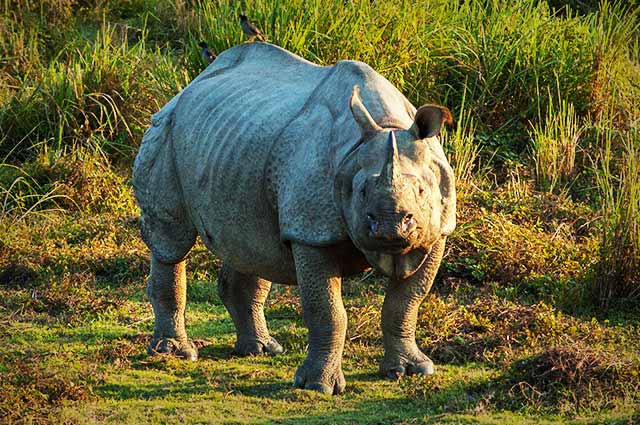
Housing around 2,400 Indian rhinos out of the total 3,500 left in the world, Kaziranga National Park is located in the Golaghat and Nagaon District of Assam. Spread across an area of 378.22 sq. km., it is a breeding ground for 35 mammalian species and 15 threatened species. Kaziranga is flocked by many migratory, water and game birds which make it an Important Bird Area as declared by Birdlife International. This famous national park of India is easily commutable by road as well as air and is open to tourists from November 1st to April 30th. You can take the Elephant Safari or the Jeep Safari that have two timings, 5:30am or 7am in the morning and 3pm or 1:30pm in the afternoon respectively.
Entry Fee- INR 100 for Indians and INR 650 for foreigners. For Elephant Safari the charges are INR 750, INR 1250 and for Jeep Safari, they charge INR 350 and INR 800 for Indians and foreigners respectively.
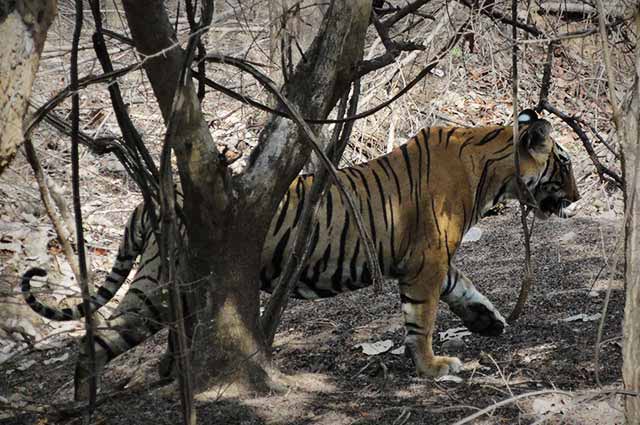
Located in the Sawai Madhopur district of Rajasthan, Ranthambore National park is a Project Tiger Reserve with more than 62 tigers inhabited within its premises. A troll through this national park and one can easily spot leopards, chital nilgai, macaques, desert cats, wild boars and many other animals. With a total of 272 species of birds, including graylag goose, hornbills, flamingos, kingfishers etc, one can easily enjoy bird watching here. This park is open between the months of October and June for visitors.
Entry Fee- INR 510 and INR 1250 for Indians and foreigners for Canter Safari. INR 750 and INR 1350 for Indians and foreigners for Gypsy Safari.

Located in the state of Jammu and Kashmir, around 22 km from Srinagar, Dachigam Wildlife Sanctuary was declared a national park in the year 1981. It is a natural habitat for the endangered hangul also known as Kashmiri Stag. One can also catch a glimpse of Himalayan black bear strolling in its own pace between Spring and Autumn. It is also a home for many other Himalayan animals like snow leopard, musk deer, marten, ibex and many more. Spread over an area of 140 sq. km., this is the most elevated national mark of the country.
Entry Fee- Free entry for all!!! Just pay for the rented car or jeep at the entrance.

Spread over a humongous area of 940 sq. km. in Madhya Pradesh, Kanha National Park is one of the largest national parks of the country. Rudyard Kipling was inspired by this very national park and created the famous Jungle Book. Naturally protecting swamp deer from extinction, this national park is a home to many other animals including tigers, barasingha, leopards. sambars, jackals, hyena and blackbuck. The park is open for public visits from October to June but being in a tropical region, it is best you visit this place in winters to enjoy a pleasant stay.
Entry Fee- INR 6500 for Indians and INR 9500 for foreigners including Jeep Safari.

A notable tigers reserve and elephant reserve, Periyar national Park is located in the Idukki District of Kerala. Spread over a sprawling area of 925 sq. km., it provides shelter to around 35 species of mammals, 266 species of birds and 45 species of reptiles. A visit to this stunning wildlife sanctuary in India and one can easily spot elephants roaming around in herds. Easily accessible by rail, road as well as air and open all year round, it is recommended to visit this park during the monsoon season.
Entry Fee- INR 25 for Indians and INR 300 for foreigners.

Located in the Kancheepuram district of Tamil Nadu is the small yet attractive Vedanthangal Bird Sanctuary. A paradise for the bird lovers, it is flocked by as many as 100,000 birds during the migratory season of the year. Known to be the oldest water bird sanctuary, it is visited by thousands of water birds from different countries. Garganeys, glossy ibises, gray herons, gray pelicans and open-billed storks are some of the migratory birds that can be seen here. Plan a tour to this bird sanctuary between the months of November and February.
Entry Fee- INR 5 for children and INR 25 for adults.

Sariska National Park, also known as Sariska Tiger Reserve, is one of the best national parks in India. Located in the Alwar District of Rajasthan, it is famous for its Bengal tigers. Apart from these, there are many other animals that can be easily found strolling in the park like hyena, leopard, jungle cat, sambar, chital etc. About 90% of the area is covered dhok trees that provide shade to the travellers. You can also find birds like peafowls, red jungle fowls, partridges, quails etc flying over your head.
Entry Fee- INR 80 for Indians and INR 470 for foreigners. INR 4200 for a Jeep Safari.

Famous for its tigers and leopards, Mundanthurai Wildlife sanctuary is an amazing wildlife sanctuary of India. Covering an area of 895 sq. km., this sanctuary is located in the Thirunelvelli district of Tamil Nadu. It is a natural habitat for numerous animals like Nilgiri Martin, brown mongoose, rusty-spotted cat, Indian pangolin, sloth bear and many more. It also has a varied vegetation cover to provide shelter to every type of wildlife. If you are an adventure lover, then take a visit to this sanctuary and reside in the forest rest house that it offers.
Entry Fee- INR 15 per head for everyone.
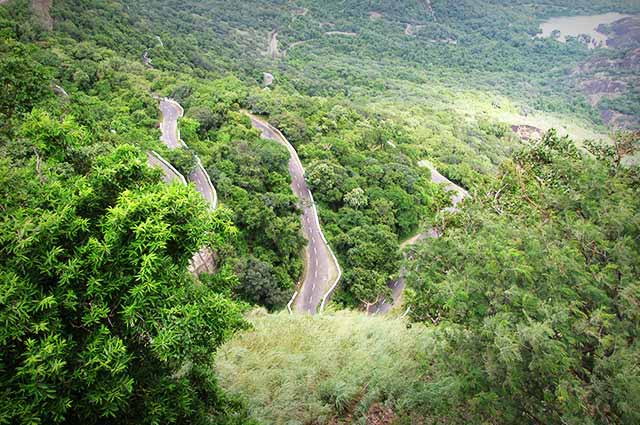
Also known as the Indira Gandhi Wildlife Sanctuary, Annamalai is one of the most beautiful natural reserves in Tamil Nadu. Situated at a distance of 90 km from Coimbatore near Pollachi, it is spread over an area of 950 sq. km. Rich in fauna, this sanctuary provides shelter to many exotic endemic wildlife like tiger, leopards, jackal, flying squirrel, wild dog, spotted dove etc. Visiting this place between October to February and May to June will help you spot all these animals even better.
Entry Fee- INR 25 per head for everyone.

Located in the Nicobar island in the eastern parts of Indian Ocean, Campbell Bay National park is a part of the Great Nicobar Biosphere Reserve. Draped in the greenery of tropical evergreen forests, it is dotted with beautiful orchids, mangrove trees and various flowering plants. Giant robber crabs, crocodiles, giant leatherback turtles, palm civet and many other animals can be seen in this national park. The months between March and October are the best time to visit this place. It is easily accessible by water and air and international tourists require permission to enter this park.
Entry Fee- Permission required by authority to visit.

An example of diverse Terai ecosystem, Dudhwa national park is a home to many endangered species like tigers and swamp deer. It is located in the Terai of Uttar Pradesh on the Indo-Nepal Border. It also houses some Indian rhinos that were shifted here from Assam and Nepal. It is also flocked by beautiful birds during winters. It is open for public visits between 15th November and 15th June.
Entry Fee- INR 50 for Indians and INR 300 for foreigners.

Elevated at a height of 3500 mt above the sea level around the peak of Nanda Devi, Nanda Devi Biosphere Reserve is located in the state of Uttarakhand. It is divided into inner and outer parts. It is well-known for its floral vegetation cover comprising of more than 312 species out of which 17 are rare. With 114 bird species and 520 species of fauna, many other wildlife like Himalayan black bear, Himalayan musk deer, langurs etc can easily be seen here.
Entry Fee-Free entry for all!!!

Want to see snow leopard roaming around in the wild? If yes, then Hemis National park is your destination. Located in the Ladakh region of Jammu and Kashmir, this national park is a home to the largest population of snow leopard (around 200) in the world. Asiatic ibex, Tibetan wolf, Himalayan marmot, mountain weasel are some of the commonly found mammals in this region. It is not very easily accessible but you can hire a private taxi from the Leh Airport or the Jammu Tavi Railway station to reach this chilly national park.
Entry Fee- INR 20 for Indians and INR 100 for foreigners.

A natural habitat for numerous wildlife species and an amazing national park with lush greenery; welcome to Bandhavgarh National Park. Nestled in the Vindhya Range of Madhya Pradesh, this park is famous for its Royal Bengal Tigers. There are 37 species of mammals, more than 250 species of birds and as many as 80 species of butterflies in this very national park. Visit this place in the months of October to June to catch a glimpse of the majestic Bengal tiger.
Entry Fee- INR 2200 for Indians and 4300 for foreigners (including guide and vehicle).

Deriving its name from the splendid Pench River flowing through the park and dividing it into two equal halves, Pench National park is visited for its tiger species. There are many more wildlife species that can be spotted while you take a stroll in this park including nilgai, jackal, chital, sloth bear, Indian leopard and striped hyena. It is also a flocking ground for many migratory birds like peafowl, red vented bulbul, magpie robin etc. To make the best of your trip here, visit the park during the months of November till May.
Entry Fee- INR 15 for Indians and INR 150 for foreigners.

Located in the far reaches of northeastern state of Sikkim is a lush green biosphere reserve called Khangchendzonga National Park. One can easily spot many animals like musk deer, clouded leopard, snow leopard, Himalayan tahr etc. To reach this national park you can also undertake the adventurous trek from Yuksom. One can hire private taxis or hop on the public bus to reach this place from Siliguri Junction or Bagdogra Airport. A visit to this place is recommended during the months of March till May as the climate is quite pleasant at this time as compared to the chilly breeze that blows in this region during winters.
Entry Fee- INR 350 for Indians, INR 560 for foreigners and INR 80 for students for the first 7 days.

Located in islands of Andaman & Nicobar, the Wandur National Park was established in 1983 and is a home to the marine species like butterfly fish, surgeon fish, water snakes, angelfish, crocodiles and water monitor lizards. Many will be surprised to know that this national is among those few that are dedicated to the marine creatures. Flights are the best option to reach the place. From Port Blair, Wandur national park is just 30 kms by road and the best time for visiting is during November and May.
Entry fee- 50 INR for adults & 25 INR for children

Bandipur is also called as the tiger reserve in the Nilgiris. This bio-sphere reserve was established in the year 1974 and was chosen for the Project Tiger. Not only tigers but Bandipur national park is inhabited by a number of other species like sloth bears, muggers, gaurs, elephants, rock pythons and 4 horned antelope. Others include owls, hawks and vultures. It is well connected and can be reached via road, railways and flight. The national park authorities offer the gypsy safari and rides to visitors.
Entry Fee- 300 INR for Indians & 1100 INR for foreigners
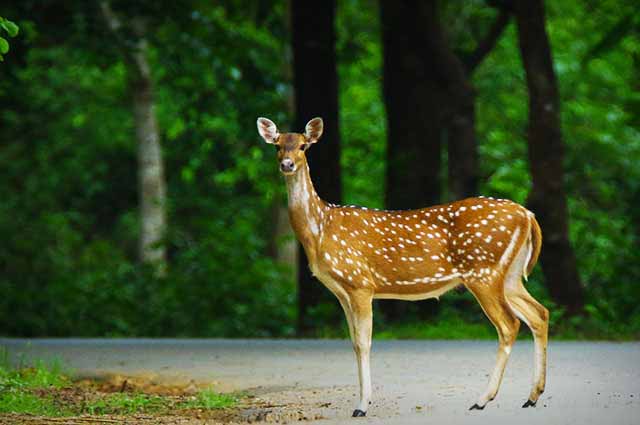
Dandeli is famous as Goas adventurous extension and was established in the year 1975. Covered with semi deciduous forests, Dandeli is a residence to many animals like leopard, panther, tiger etc. The flying squad includes the hornbill, eagle, woodpecker etc. Dandeli wild life sanctuary can be accessed best via roadways because flights cost more. It can be visited in all the seasons by keeping aside the monsoons. Daily safari rides are offered to the visitors for exploring the beauty of sanctuary.
Entry fee- 40 INR for Indians & 80 INR for foreigners
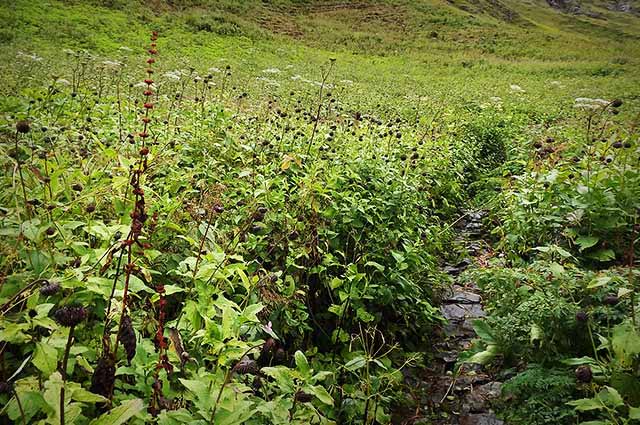
The Valley Of Flowers National Park is located in Chamoli district of Uttarakhand and is a world heritage site. It was established in the year 1980. The valley boasts a vast variety of flowers and their fragrance can be smelled from 2 kilometers away. It was also known as Sanjay Gandhi national park but was renamed as Nanda Devi national park. Many endangered species including the snow leopard, Himalayan black bear, red fox and spotted dove are a few to be named. It can be reached by road the best as railways are connected only till Rishikesh. The best time to visit is from July till October.
Entry fee- No entry fee

Established in the year 1981, Panna national park is the 22nd tiger reserve of India and 5th in Madhya Pradesh. The orange and black striped big cats are found here in abundance but the place is also inhabited by chitals, nilgais, sloth bears etc. Panna National Park is also a home to over 200 species of the birds including king vulture and blossom headed parakeet. It can be reached best by roads due to frequent bus services in Panna town. Safari time is best suited from October till January.
Entry fee- 1250 INR for Indians & 2250 for foreigners

Located in the Garo hill of Meghalaya, the Balpakram National Park is the place where a combination of herbs and animals exists. The deciduous forest in the Garo hills produce a wide variety of herbs that are used for various medical purposes and the animals that reside in the woods are barking deer, rare golden, elephants and others. The flying fleet consist the sparrows that are extinct in cities. Balpakram National Park can be reached best in the months from October to April via roads. Bus safari service is available in the premises.
Entry fee- Information unavailable

With its foundation laid in the year 1980, Simlipal National Park is the home to 102 royal Bengal tigers and many elephants. Boasting 42 species of mammals, it is one of the popular tiger reserves in the country. Its boundary adjoins with 2 other sanctuaries namely Kuldiha and Hadgarh wildlife sanctuary. Similipal National Park can be best visited around the year via roadways. Bus safaris are available for the tourists. One should be extra cautious as Similipal falls under cerebral malaria zone.
Entry Fee - 40 INR for Indians & 1000 INR for foreigners

Declared as a national park by the government of Karnataka, Kudremukh National Park has also made its name in the list of world heritage sites. Kudremukh National Park is inhabited by a large number of lion-tailed macaques. It is partly spread over thick hilly forests and covers the area of Chickamagalur, Udupi and Daskhine Kannada. There is no access through railways, but KNP is well connected via roads and one must visit there from November to February. The safaris are carried out for the visitors so that they can see the fauna in the natural habitat.
Entry Fee- 200 INR for Indians & 1000 INR for foreigners

In 1978, Eravikulam wildlife sanctuary was officially declared as a national park, and it is another world heritage site. It stands out for the ravishing beauty of its rolling grasslands and sholas, spread over 97 sq km in the Kannan devan hills. Eravikulam National Park is largely inhabited by leopards, tigers, mongooses, deer, tahr etc. and is open for visitors throughout the year. Kottayam, 142 kms, and Ernakulam, 130 kms, are the nearest railway stations to Eravikulam, therefore, easy access is guaranteed.
Entry Fee- 90 INR for Indians & 370 INR for foreigners

Located in Karnataka, the Bannerghatta National Park was established in the year 1971 and is bordered by 16 villages. It also houses the countrys first butterfly reserve that makes it unique from the rest of reserves and sanctuaries. Bannerghatta is a home to different mammalians including the white tiger, hippos, langurs, deer, elephants etc. Reaching here isnt hectic as bannerghatta is located on the outskirts of Bangalore that is well connected by public transports.
Bannerghatta National Park can be visited around the calendar.
Entry Fee- 80 INR for Indians & 400 INR for foreigners

Chinnar wildlife sanctuary was established in 1984 and is located in the Western Ghats, sharing its borders with Tamil Nadu on Annamalai hills. The Pambar River and Thoovnam waterfalls add an extra beauty to the place. Spotted deer, tahr, panthers, tigers, elephants are the spectacular ones to be seen here among the 34 species of animals. Chinnar wildlife sanctuary is open to visitors in all months excluding monsoons. One can reach by airways, roadways or railways but roadways emerge as a champ as they have the minimum distance.
Entry Fee- 100 INR for Indians & 150 INR for foreigners

Dibru Saikhowa wildlife sanctuary is an 18 year old wildlife sanctuary that was established in the year 1999. DSWS is merely 13 kms away from Tinsukia and is a home to various species like gibbons, wild boar, capped langur, clouded leopard, wild horse to be named a few. Connectivity is quite decent as trains head straight to the town of Tinsukia and from there a small road journey. For seeing the best of fauna, October-April is the right time and safari services are available at minimal prices.
Entry Fee- 200 INR for Indians & 600 INR for foreigners

The scenic crystal waters and deciduous woods of the sanctuary give calmness to the senses. Located in the heart of the country, Madhya Pradesh, National Chambal Sanctuary was established in 1979 and is a residence to alligators, rare red neck turtles and visitor dolphins. It has an easy connectivity via all 3 modes of transport but railways steals major traction as journey to the sanctuary gets completed just in an hour or so. Right time to capture the amphibian moments is the monsoon season.
Entry Fee- 200 INR for Indians & 600 INR for foreigners

With the beauty of nature on the banks of river Brahmaputra in Sonitpur district of Assam, Orang National Park was established in the year 1999 and is a home to a variety of birds like scavenger birds and migratory birds like fish eagle, black breast hawk, pelicans, storks and geese. The four legged pals that wander here are the tigers, boars, elephants and rhinos. Orang National Park can be reached via roads and railways easily, though a taxi journey will take to the park after de-boarding the train. Best suited months are October to March to enjoy the safari ride.
Entry Fee- 20 INR for Indians & 250 INR for foreigners

One of the oldest reserved forests from 1895, Gorumara was declared as a National Park in 1994 and is located in the land of the composer of Indian National Anthem. Set in the Terai region of Himalayan foothills, Gorumara is forest grassland inhabited by the great Indian rhinoceros on a large scale followed by Asian elephants, Indian wild dogs, Bengal tiger, Indian wolves etc. The park has certain machan-points from where a clear view of herd of rhinos can be spotted. Reaching here is made easier via roadways and railways but flights steal the limelight. Visiting seasons exclude summers and monsoon.
Entry Fee- No entry fee

Located in the laps of Garo hills in Meghalaya, Nokrek National Park is also a bio sphere reserve and came into existence in the late 1960s. UNESCO added the park into its list of biosphere reserves in May 2009. Nokrek National Park boasts various mammal species that include stump-tailed macaque, hoolocks, tiger cat and elephants. If you stay out of Meghalaya then you need to fly till here. Shillong airport is the nearest, 60 kms, and then take roadways to reach the Nokrek National park that is merely a few more kms away. November-May is the best time for visiting.
Entry Fee- No entry fee

Situated in the Changlang district of Arunachal Pradesh, Namdapha National Park was established in the year 1974. Since it shares the borders with Myanmar, a diverse species assemblage is seen here. Animals like snow leopards, tigers, wolves, black bears, red panda, fox etc are few to be named that reside here. The pleasant weather during November-February becomes the right time for visiting and enjoying the jeep safari in Namdapha National Park. First reach here via flight or roads at Dibrugarh and then hire a jeep to reach the park.
Entry Fee- 50 INR for Indians & 350 for foreigners

Located on the sandy shores of Gulf of Kutch, Gujarat, the marine national park was born in the year 1982 and is among the few marine national parks all over India. Most of the islands that surround the Jamnagar on the coast are reefs. Marine National Park is a home sweet home to over 70 water species that include whale sharks, sea horse, jelly fish, crabs, lobsters, shrimps, octopus, turtles etc to be named a few. It is well connected via airways and roadways. Nearest airports are Bhuj and Kandla that are a few kms away from the marine park. Chuck the summers and all other seasons are suited the best.
Entry fee- 150 INR for Indians & foreigners

Located in Kundali hills of Western ghats in Gods own country, Kerela and with its lush green forests, Silent Valley National Park holds a great significance as it is the last tropical evergreen forest left in India. Established in the year 1980, SVNP is a home to many species like peshwa bats, red wing crested cuckoo, black bulbul, Nilgiri langur, deer, panthers etc. The best time to visit is from November-April as pleasant weather welcomes the visitors. It is well connected via airways and railways where a short road trip of 2-3 hours has to be made to reach the park.
Entry Fee- 50 INR for Indians
Located in the Thoothukudi district of Tamil Nadu, the Gulf of Mannar Marine National Park is not less than a paradise for the marine lovers. This is one of the largest visited marine parks in India that is a home to different whales, dolphins, turtles, fishes etc. The crystal water boat safari is the attraction of this national park and the best time to enjoy this is from October-March. With a decent reach, one can fly to here or travel through railways.
Entry Fee- 10 INR for Indian adults

The very famous chota Nagpur plateau in Palamu district of Jharkhand has Betla National Park that is considered as Indias one of the best national parks. Surrounded with lush greenery, Betla National Park is a home to a wide fauna like monkeys, nilgais, mouse deer, antelopes, serpent killer eagle are few to be named. Betla is extremely well connected via roads and is best suited when you keep aside the monsoon season.
Entry Fee- 100 INR for Indians & 200 for Foreigners
India is a diverse country not only in terms of religious ethnicities found here, but also for the variety of flora and fauna spread in all the 4 directions across the country. All the national parks have helped the wild to inhabit in the natural habitats by preserving them from all kinds of harms. This is a great step taken by the regional governments to save those pals that have a full right to share the land and waters like ours. The friends with tails and wings are an important part of the eco-system, hence preserving them becomes an essential responsibility. Moreover, the zoos are not completely capable and that advocates the reason of setting the wild free into their natural habitat. The sanctuaries in India allow the visitors to take a closer look at the creatures with hooves, paws and claws with complete safety during safaris.